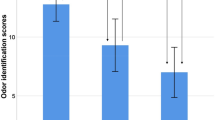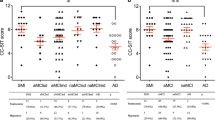Abstract
Purpose
Olfactory identification disorder is considered a promising early biomarker of Alzheimer's disease (AD). The QUICK TODA2 can be used as a short olfactory screening tool specific for French AD patients. The selection of AD specific odorants and the design of this screening were the main objectives of this twofold study.
Methods
In study 1, the TODA2 olfactory test was administered to 43 mild-AD patients and 45 healthy controls (HC) in five memory centres in France. The selection of AD specific odorants was based on the differences in the proportion of correct answers and in the threshold means between AD and HC groups. In study 2, another set of 19 mild-AD patient were included at the memory centre of Nice Hospital. All participants completed the olfactory assessment pipeline including the QUICK TODA2, TODA2 and Sniffin’ Sticks Identification sub-Test (SST-i). The individual scores of the three tests were correlated.
Results
In study 1, ten TODA2 odorants could significantly differentiate AD participants from controls. We selected the six most AD-sensitive items to design the QUICK TODA2. In study 2, we reported strong significant correlations between QUICK TODA2 and TODA2 (ρ(17) = 0.68, p = 0.001**), SST-i and QUICK TODA2 (ρ(17) = 0.65, p = 0.002**), SST-i and TODA2 (ρ(17) = 0.57, p = 0.01*).
Conclusion
QUICK TODA2 is a 5-min non-invasive olfactory AD screening tool dedicated to French culture. Its results converge with those of longer, validated olfactory tests. It could be used as a quick screening tool in the general daily practice before an extensive assessment in memory centres.


Similar content being viewed by others
Data availability
Not applicable.
References
Demarquay G, Ryvlin P, Royet JP (2007) Olfaction et pathologies neurologiques: revue de la littérature. Revue Neurolog 163:155–167. https://doi.org/10.1016/S0035-3787(07)90387-2
Serby M, Larson P, Kalkstein D (1991) The nature and course of olfactory deficits in Alzheimer’s disease. AJP 148:357–360. https://doi.org/10.1176/ajp.148.3.357
Devanand DP, Michaels-Marston KS, Liu X, Pelton GH, Padilla M, Marder K, Bell K, Stern Y, Mayeux R (2000) Olfactory deficits in patients with mild cognitive impairment predict Alzheimer’s disease at follow-up. AJP 157:1399–1405. https://doi.org/10.1176/appi.ajp.157.9.1399
Naudin M, Mondon K, Atanasova B (2013) Alzheimer’s disease and olfaction. Gériatrie et Psychologie Neuropsychiatrie du Viellissement 11:287–293. https://doi.org/10.1684/pnv.2013.0418
Hedner M, Larsson M, Arnold N, Zucco GM, Hummel T (2010) Cognitive factors in odor detection, odor discrimination, and odor identification tasks. J Clin Exp Neuropsychol 32:1062–1067. https://doi.org/10.1080/13803391003683070
Rahayel S, Frasnelli J, Joubert S (2012) The effect of Alzheimer’s disease and Parkinson’s disease on olfaction: a meta-analysis. Behav Brain Res 231:60–74. https://doi.org/10.1016/j.bbr.2012.02.047
Lafaille-Magnan M-E, Poirier J, Etienne P, Tremblay-Mercier J, Frenette J, Rosa-Neto P, Breitner JCS, For the PREVENT-AD Research Group (2017) Odor identification as a biomarker of preclinical AD in older adults at risk. Neurology 89:327–335. https://doi.org/10.1212/WNL.0000000000004159
Ottaviano G, Frasson G, Nardello E, Martini A (2016) Olfaction deterioration in cognitive disorders in the elderly. Aging Clin Exp Res 28:37–45. https://doi.org/10.1007/s40520-015-0380-x
Sun GH, Raji CA, MacEachern MP, Burke JF (2012) Olfactory identification testing as a predictor of the development of Alzheimer’s dementia: A systematic review. Laryngoscope 122:1455–1462. https://doi.org/10.1002/lary.23365
McKhann GM, Knopman DS, Chertkow H, Hyman BT, Jack CR, Kawas CH, Klunk WE, Koroshetz WJ, Manly JJ, Mayeux R, Mohs RC, Morris JC, Rossor MN, Scheltens P, Carrillo MC, Thies B, Weintraub S, Phelps CH (2011) The diagnosis of dementia due to Alzheimer’s disease: Recommendations from the National Institute on Aging-Alzheimer’s Association workgroups on diagnostic guidelines for Alzheimer’s disease. Alzheimer’s & Dementia 7:263–269. https://doi.org/10.1016/j.jalz.2011.03.005
Hummel T, Whitcroft KL, Andrews P, Altundag A, Cinghi C, Costanzo RM, Damm M, Frasnelli J, Gudziol H, Gupta N, Haehne A, Holbrook E, Hong SC, Hornung D, Huttenbrink KB, Kamel R, Kobayashi M, Konstantinidis I, Landis BN, Leopold DA, Macchi A, Miwa T, Moesges R, Mullol J, Mueller CA, Ottaviano G, Passali GC, Philpott C, Pinto JM, Ramakrishnan VJ, Rombaux P, Roth Y, Schlosser RA, Shu B, Soler G, Stjarne P, Stuck BA, Vodicka J, Welge-Luessen A (2017) Position paper on olfactory dysfunction. Rhin 54:1–30. https://doi.org/10.4193/Rhino16.248
Hummel T, Sekinger B, Wolf SR, Pauli E, Kobal G (1997) “Sniffin” Sticks’: olfactory performance assessed by the combined testing of odor identification, odor discrimination and olfactory threshold. Chem Senses 22:39–52. https://doi.org/10.1093/chemse/22.1.39
Doty RL (2007) Office procedures for quantitative assessment of olfactory function. Am J Rhinol 21:460–473. https://doi.org/10.2500/ajr.2007.21.3043
Gros A, Manera V, De March CA, Guevara N, König A, Friedman L, Robert P, Golebiowski J, David R (2017) Olfactory disturbances in ageing with and without dementia: towards new diagnostic tools. J Laryngol Otol 131:572–579. https://doi.org/10.1017/S0022215117000858
Nordin S, Monsch AU, Murphy C (1995) Unawareness of smell loss in normal aging and Alzheimer’s disease: discrepancy between self-reported and diagnosed smell sensitivity. J Gerontol B Psychol Sci Soc Sci 50B:P187–P192. https://doi.org/10.1093/geronb/50B.4.P187
Tahmasebi R, Zehetmayer S, Stögmann E, Lehrner J (2020) Awareness of olfactory dysfunction in subjective cognitive decline, mild cognitive decline, and Alzheimer’s disease. Chem Percept 13:59–70. https://doi.org/10.1007/s12078-019-09267-7
Doty RL, Reyes PF, Gregor T (1987) Presence of both odor identification and detection deficits in Alzheimer’s disease. Brain Res Bull 18:597–600. https://doi.org/10.1016/0361-9230(87)90129-8
Payne M, Manera V, Robert P, Vandersteen C, Beauchet O, Galery K, Sacco G, Fabre R, Gros A (2022) Olfactory identification disorders due to Alzheimer’s disease: a new test from France to Quebec. PLoS ONE 17:e0265764. https://doi.org/10.1371/journal.pone.0265764
American Psychiatric Association (2022) DSM-5: diagnostic and statistical manual of mental disorders, 5th edition, Text revision (DSM-5-TR®)
Organisation Mondiale de la Santé (1994) CIM-10 Classification Internationale des Maladies et des Troubles Mentaux et troubles du Comportement, Critères Diagnostiques pour la Recherche, Elsevier Masson
Folstein MF, Folstein SE, McHugh PR (1975) Mini-mental state. J Psychiatr Res 12:189–198. https://doi.org/10.1016/0022-3956(75)90026-6
Tabert MH, Liu X, Doty RL, Serby M, Zamora D, Pelton GH, Marder K, Albers MW, Stern Y, Devanand DP (2005) A 10-item smell identification scale related to risk for Alzheimer’s disease. Ann Neurol 58:155–160. https://doi.org/10.1002/ana.20533
Woodward MR, Amrutkar CV, Shah HC, Benedict RHB, Rajakrishnan S, Doody RS, Yan L, Szigeti K (2017) Validation of olfactory deficit as a biomarker of Alzheimer disease. Neurol Clin Pract 7:5–14. https://doi.org/10.1212/CPJ.0000000000000293
Woodward MR, Hafeez MU, Qi Q, Riaz A, Benedict RHB, Yan L, Szigeti K, Pavlik V, Massman P, Darby E, Rodriguear M, Khaleeq Ansari A, DeToledo JC, Reddy H, Wilms H, Johnson K, Perez V, Fairchild T, Knebl J, O’Bryant SE, Hall JR, Johnson L, Barber RC, Mains D, Alvarez L, Cullum M, Rosenberg R, Williams B, Quiceno M, Reisch J, Hynan LS, Huebinger R, Smith J, Nguyen T, Royall D, Palmer R, Polk M, Stevens A, Ory M, Paydarfar D, Bertelson J, Woon M, Ayres G, Aguirre A, Wilhelmsen KC, Tilson JL (2018) Odorant item specific olfactory identification deficit may differentiate Alzheimer disease from aging. Am J Geriatr Psychiatry 26:835–846. https://doi.org/10.1016/j.jagp.2018.02.008
Jimbo D, Inoue M, Taniguchi M, Urakami K (2011) Specific feature of olfactory dysfunction with Alzheimer’s disease inspected by the odor stick identification test: olfactory loss for diagnosing AD. Psychogeriatrics 11:196–204. https://doi.org/10.1111/j.1479-8301.2011.00387.x
Zendehbad AS, Noroozian M, Shakiba A, Kargar A, Davoudkhani M (2022) Validation of Iranian Smell Identification Test for screening of mild cognitive impairment and Alzheimer’s disease. Appl Neuropsychol Adult 29:77–82. https://doi.org/10.1080/23279095.2019.1710508
Doty RL, Shaman P, Dann M (1984) Development of the university of pennsylvania smell identification test: A standardized microencapsulated test of olfactory function. Physiol Behav 32:489–502. https://doi.org/10.1016/0031-9384(84)90269-5
Stamps JJ, Bartoshuk LM, Heilman KM (2013) A brief olfactory test for Alzheimer’s disease. J Neurol Sci 333:19–24. https://doi.org/10.1016/j.jns.2013.06.033
Doty RL, Bayona EA, Leon-Ariza DS, Cuadros J, Chung I, Vazquez B, Leon-Sarmiento FE (2014) The lateralized smell test for detecting Alzheimer’s disease: failure to replicate. J Neurol Sci 340:170–173. https://doi.org/10.1016/j.jns.2014.03.022
Kjelvik G, Sando SB, Aasly J, Engedal KA, White LR (2007) Use of the Brief Smell Identification Test for olfactory deficit in a Norwegian population with Alzheimer’s disease. Int J Geriat Psychiatry 22:1020–1024. https://doi.org/10.1002/gps.1783
Albrecht T, Beule AG, Hildenbrand T, Gerstacker K, Praetorius M, Rudack C, Baumann I (2022) Cross-cultural adaptation and validation of the 22-item sinonasal outcome test (SNOT-22) in German-speaking patients: a prospective, multicenter cohort study. Eur Arch Otorhinolaryngol 279:2433–2439. https://doi.org/10.1007/s00405-021-07019-6
Yoshitake M, Maeshima E, Maeshima S, Osawa A, Ito N, Ueda I, Kamiya M (2022) Olfactory identification ability in patients with mild cognitive impairment and Alzheimer’s disease. J Phys Ther Sci 34:710–714. https://doi.org/10.1589/jpts.34.710
Silveira-Moriyama L, Azevedo AMS, Ranvaud R, Barbosa ER, Doty RL, Lees AJ (2010) Applying a new version of the Brazilian-Portuguese UPSIT smell test in Brazil. Arq Neuro-Psiquiatr 68:700–705. https://doi.org/10.1590/S0004-282X2010000500005
Jiang R-S, Su M-C, Liang K-L, Shiao J-Y, Wu S-H, Hsin C-H (2010) A pilot study of a traditional Chinese version of the University of Pennsylvania Smell Identification Test for application in Taiwan. Am J RhinoloAllergy 24:45–50. https://doi.org/10.2500/ajra.2010.24.3388
Chrea C, Valentin D, Abdi H (2009) Graded structure in odour categories: a cross-cultural case study. Perception 38:292–309. https://doi.org/10.1068/p5687
Chrea C, Valentin D, Sulmont-Rossé C, Ly Mai H, Hoang Nguyen D, Abdi H (2004) Culture and odor categorization: agreement between cultures depends upon the odors. Food Qual Prefer 15:669–679. https://doi.org/10.1016/j.foodqual.2003.10.005
Hummel T, Pfetzing U, Lötsch J (2010) A short olfactory test based on the identification of three odors. J Neurol 257:1316–1321. https://doi.org/10.1007/s00415-010-5516-5
Sorokowska A, Oleszkiewicz A, Minovi A, Konnerth CG, Hummel T (2019) Fast screening of olfactory function using the Q-sticks test. ORL 81:245–251. https://doi.org/10.1159/000500559
Hummel T, Rosenheim K, Konnerth C-G, Kobal G (2001) Screening of olfactory function with a four-minute odor identification test: reliability, normative data, and investigations in patients with olfactory loss. Ann Otol Rhinol Laryngol 110:976–981. https://doi.org/10.1177/000348940111001015
Hüttenbrink K-B, Hummel T, Berg D, Gasser T, Hähner A (2013) Olfactory dysfunction. Dtsch Arztebl Int. https://doi.org/10.3238/arztebl.2013.0001
Acknowledgements
We thank the perfumer Payan Bertrand represented by Laure de St Lary, Head of Research and Innovation and Aude Galouye, Nose perfumeur, for their help in the design of the odours; the students of the Master Foqual for their contribution to the formulation of the olfactory kit.
Author information
Authors and Affiliations
Contributions
Conceptualization: AG, VM, MP, XF, AD, ClV; methodology: VM, AG; formal analysis and investigation: VM, AG, AP, MP, AM, GS, JL, AF-K-C; writing—original draft preparation: AF-K-C; writing—review and editing: all authors; supervision: AG, VM.
Corresponding author
Ethics declarations
Conflict of interest
The authors declare that they have no competing interests.
Additional information
Publisher's Note
Springer Nature remains neutral with regard to jurisdictional claims in published maps and institutional affiliations.
Rights and permissions
Springer Nature or its licensor (e.g. a society or other partner) holds exclusive rights to this article under a publishing agreement with the author(s) or other rightsholder(s); author self-archiving of the accepted manuscript version of this article is solely governed by the terms of such publishing agreement and applicable law.
About this article
Cite this article
Feing-Kwong-Chan, A., Manera, V., Payne, M. et al. The first quick olfactory test specific for Alzheimer’s disease and French culture. Eur Arch Otorhinolaryngol 281, 757–766 (2024). https://doi.org/10.1007/s00405-023-08217-0
Received:
Accepted:
Published:
Issue Date:
DOI: https://doi.org/10.1007/s00405-023-08217-0




